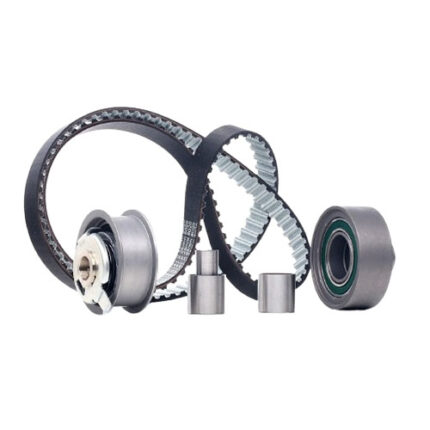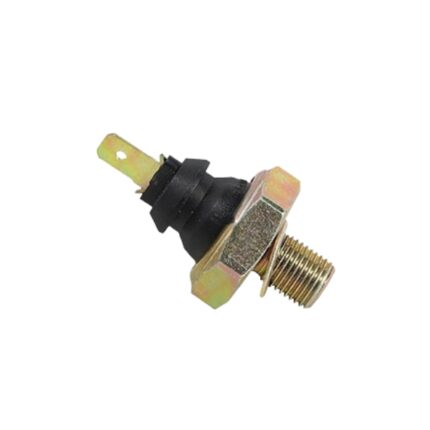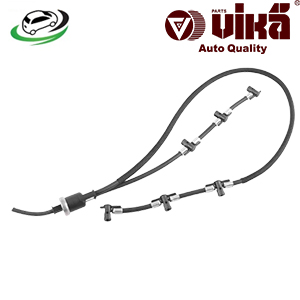Get Fuel Return Hose / Overflow / Leak Off Pipe AUDI A4 (8K2/B8)/A4 Avant (8ED/B7)/A5 (8T3)/A6 (4F2/C6) 059130218H
The fuel return hose, also known as the overflow or leak-off pipe, is an essential component of a vehicle’s fuel system, especially in diesel engines. Its primary role is to return excess fuel from the fuel injectors back to the fuel tank or the fuel pump, ensuring that the fuel system operates efficiently and effectively. This hose helps in managing the fuel flow, preventing fuel wastage, and maintaining proper engine performance. This overview will cover the design, function, importance, types, common issues, and maintenance of the fuel return hose.
Design and Function
Design:
- Material:
- Rubber: Most fuel return hoses are made from high-quality rubber, which is resistant to fuel, oil, and other automotive fluids. Rubber hoses are flexible, durable, and can withstand the high pressures and temperatures typically found in fuel systems.
- Reinforcement: Some hoses are reinforced with layers of synthetic fabric or metal braiding to enhance their strength and resistance to wear, ensuring longevity even under harsh operating conditions.
- Inner Lining: The inner lining of the hose is often made of a material that is resistant to fuel and chemical degradation, preventing leaks and ensuring a long service life.
- Shape and Structure:
- Flexibility: The hose is designed to be flexible enough to navigate the various components of the engine bay while maintaining a tight seal at connection points. It must bend around engine parts without kinking, which could obstruct fuel flow.
- Connections: The hose typically features specific fittings or connectors at both ends to ensure a secure attachment to the fuel injectors, fuel pump, or fuel tank. These connectors are designed to prevent leaks and withstand the pressure within the fuel system.
Functionality:
- Fuel Overflow Management:
- Excess Fuel Return: The primary function of the fuel return hose is to channel excess fuel that is not used by the injectors back to the fuel tank or fuel pump. This recirculation helps to maintain a consistent fuel pressure within the system, which is crucial for optimal engine performance.
- Pressure Regulation: By returning excess fuel, the hose plays a key role in regulating the pressure within the fuel injectors, ensuring they operate correctly. Proper pressure regulation prevents fuel delivery issues and ensures smooth engine operation.
- Fuel Cooling:
- Heat Dissipation: As fuel circulates through the engine, it can absorb heat. The return of excess fuel to the tank helps to dissipate this heat, preventing the fuel from becoming too hot and potentially causing vapor lock or other issues that could affect engine performance.
- Fuel Cooling: This process also helps to cool the fuel injectors themselves, preventing them from overheating, which can lead to reduced efficiency or failure over time.
- Leak Prevention:
- Sealed System: The hose ensures that the fuel system remains sealed, preventing fuel from leaking into the engine bay or onto the ground. This not only reduces the risk of fire but also prevents fuel wastage and environmental contamination.
- Safety: By securely returning excess fuel to the tank, the hose plays a vital role in maintaining the overall safety of the vehicle’s fuel system.
Importance of the Fuel Return Hose
- Engine Performance:
- Fuel Pressure Stability: A well-functioning fuel return hose helps maintain stable fuel pressure within the injectors, which is critical for accurate fuel delivery. Stable fuel pressure ensures that the engine receives the correct amount of fuel for combustion, resulting in optimal performance.
- Preventing Fuel Starvation: By returning excess fuel, the hose prevents fuel starvation, which could lead to engine misfires, poor acceleration, and other performance issues.
- Fuel Efficiency:
- Reduced Wastage: The fuel return hose ensures that unused fuel is not wasted but rather recirculated back into the system. This contributes to better fuel efficiency, as the vehicle makes the most of the fuel that is pumped into the engine.
- Cost Savings: Improved fuel efficiency translates into cost savings for the vehicle owner, as less fuel is wasted, and the engine runs more efficiently.
- Emissions Control:
- Lower Emissions: By ensuring that the engine runs smoothly and efficiently, the fuel return hose helps reduce harmful emissions. Proper fuel management prevents incomplete combustion, which is a major source of pollutants such as unburned hydrocarbons and carbon monoxide.
- Environmental Impact: Reduced emissions contribute to a lower environmental impact, making the fuel return hose an important component in vehicles that must meet strict emissions standards.
Types of Fuel Return Hoses
- Rubber Hoses:
- Standard Type: The most common type of fuel return hose is made from rubber. These hoses are durable, flexible, and resistant to fuel and heat, making them suitable for most vehicles.
- Application: Rubber hoses are widely used in both gasoline and diesel engines, providing reliable performance under normal operating conditions.
- Braided Hoses:
- Reinforced Design: Braided fuel return hoses are reinforced with a layer of metal or synthetic fiber braiding. This reinforcement increases the hose’s strength and resistance to high pressures and temperatures.
- Application: These hoses are often used in high-performance or heavy-duty engines where greater durability and resistance to harsh conditions are required.
- Nylon Hoses:
- Lightweight and Durable: Nylon fuel return hoses are lightweight, durable, and resistant to corrosion. They are often used in modern vehicles where weight reduction and longevity are important considerations.
- Application: Nylon hoses are commonly used in newer vehicles, offering advantages such as reduced weight and improved chemical resistance.
Common Issues with Fuel Return Hoses
- Wear and Tear:
- Causes: Over time, the fuel return hose can experience wear and tear due to constant exposure to fuel, heat, and engine vibrations. The rubber may degrade, crack, or become brittle, leading to potential leaks.
- Signs: Symptoms of wear include visible cracks, hardening of the hose material, and the presence of fuel odors in the engine bay. In severe cases, fuel may leak from the hose, leading to reduced engine performance and potential safety hazards.
- Leaks:
- Causes: Leaks can occur if the hose becomes damaged, worn, or if the connectors at either end of the hose are not properly sealed. Leaks can also result from the hose rubbing against other engine components, causing abrasions or punctures.
- Signs: Signs of a leak include a strong smell of fuel, visible fuel on the ground or engine components, and a drop in fuel pressure, which can lead to poor engine performance and increased fuel consumption.
- Clogging:
- Causes: Clogging can occur if debris or contaminants enter the fuel system and become trapped in the return hose. This can restrict fuel flow, leading to an imbalance in fuel pressure and potential engine issues.
- Signs: Symptoms of a clogged fuel return hose include irregular engine performance, difficulty starting the engine, and reduced fuel efficiency. In some cases, the engine may stall or misfire due to insufficient fuel flow.
- Kinking or Bending:
- Causes: Improper installation or excessive bending of the hose can cause kinks, which restrict fuel flow and affect the performance of the fuel system. Kinking is more likely to occur in hoses that are too long or improperly routed.
- Signs: Signs of kinking include fluctuating fuel pressure, reduced engine performance, and visible deformities in the hose. A kinked hose may also lead to premature wear and potential leaks.
Maintenance and Inspection
- Regular Inspection:
- Visual Checks: Periodically inspect the fuel return hose for signs of wear, damage, or leaks. Look for cracks, hardening, or discoloration of the hose material, as well as any fuel odors in the engine bay.
- Check Connections: Ensure that the hose is securely connected at both ends and that the fittings are tight and free from corrosion or damage.
- Replacement Intervals:
- Follow Manufacturer’s Recommendations: Replace the fuel return hose according to the manufacturer’s recommended intervals or if any signs of wear or damage are detected. Regular replacement helps prevent leaks and ensures the fuel system operates efficiently.
- Inspect During Major Services: During major engine services, such as timing belt replacement or injector maintenance, inspect the fuel return hose for any signs of wear or potential issues.
- Proper Installation:
- Avoid Kinking: When installing a new fuel return hose, ensure that it is properly routed and not kinked or bent excessively. The hose should have a smooth path with no sharp bends that could restrict fuel flow.
- Secure Connections: Make sure all connections are secure and that the hose is properly seated on the fittings. Use the correct clamps or connectors as specified by the manufacturer to prevent leaks.
- Monitor for Issues:
- Pay Attention to Symptoms: If you notice any symptoms of fuel system issues, such as a drop in fuel efficiency, difficulty starting the engine, or fuel odors, inspect the fuel return hose as a potential cause.
- Seek Professional Help: If you are unsure about the condition of the fuel return hose or if it requires replacement, seek assistance from a qualified mechanic. Proper diagnosis and repair are essential for maintaining engine performance and safety.
Replacing the Fuel Return Hose
- Preparation:
- Gather Tools: Gather the necessary tools, including the replacement hose, clamps, and any required fittings. You may also need pliers, screwdrivers, and a fuel line disconnect tool, depending on the vehicle.
- Consult the Manual: Refer to the vehicle’s service manual for specific instructions on replacing the fuel return hose, including the recommended tools and procedures.
- Remove the Old Hose:
- Access the Hose: Access the fuel return hose by lifting the vehicle and supporting it securely, if necessary. Remove any components or covers that obstruct access to the hose.
- Disconnect the Hose: Carefully disconnect the hose from the fuel injectors, fuel pump, or fuel tank. Be prepared for some fuel to spill, and use a catch pan to collect any excess fuel.
- Install the New Hose:
- Attach the New Hose: Attach the new fuel return hose to the appropriate fittings, ensuring that it is properly seated and secure. Use new clamps or connectors as recommended by the manufacturer.
- Check for Kinks: Ensure that the hose is routed correctly and that there are no kinks or bends that could restrict fuel flow.
- Reassemble and Test:
- Reassemble Components: Reinstall any components or covers that were removed during the replacement process. Double-check all connections to ensure they are tight and secure.
- Test the System: Start the engine and monitor for any signs of leaks or irregular engine performance. Check for fuel odors or visible fuel around the hose connections.
Follow us on Facebook for more parts.



